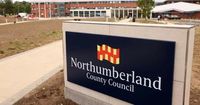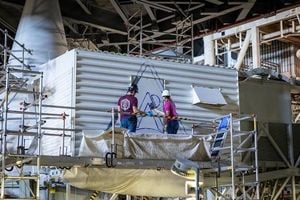In a bold move that’s drawing attention from both conservationists and developers, Northumberland County Council’s development company has unveiled plans to transform Potland Burn, a former mining site near Ashington, into a sprawling nature reserve. The decision, described by Advance Northumberland CEO Steven Harrison as a “win-win,” comes after years of uncertainty and failed ambitions to turn the land into a housing development.
The journey to this point has been anything but straightforward. Back in 2017, the council purchased the Potland Burn site for £4.5 million, eyeing it as a potential location for new homes. However, the legacy of its mining past quickly became a stumbling block. According to multiple reports from ChronicleLive and Northumberland Gazette, the site’s history as an opencast mine rendered it challenging, if not outright impossible, for traditional development. Not only were there significant structural concerns, but planning authorities were also reluctant to give the green light for housing.
“The site is a restored opencast mine which renders it difficult for development. There had been ambition to establish housing but that didn’t receive a warm welcome from planning, and it was a difficult site,” Harrison explained. “We don’t know whether it would have been viable even if it was acceptable in planning terms. This is making the most of a real opportunity, I see it as a real win-win.”
With housing plans shelved, the council faced a dilemma: what to do with a so-called “stranded asset” that, as a report to councillors bluntly put it, had “no income-generating possibilities.” Rather than letting the land sit idle, Advance Northumberland pivoted to a new and increasingly popular approach—habitat banking and biodiversity net gain (BNG) credits.
Here’s how it works: under UK law, developers are now required to ensure that any new building project results in at least a 10% net gain in biodiversity. If a developer can’t achieve this on their own site, they must compensate by investing in off-site improvements—enter the habitat bank. Potland Burn, with its 345 hectares of potential new woodland, grassland, and watercourses, is now being positioned as a key supplier of these BNG credits.
“Any developer or builder who is proposing a new development needs to determine the number of credits that are within the site they’re developing. They then need to be replaced and increased by 10%, either within the site or making the balance up elsewhere,” Harrison detailed. “We have 345 hectares at Potland Burn which is 693 units of BNG that are available. We intend to sell off biodiversity credits focusing on companies developing in Northumberland.”
The financial implications are significant. The council had previously backed the site with a £7.5 million loan, and the business case for the habitat bank predicts this could be repaid within five years through the sale of BNG credits. In fact, Harrison is optimistic: “We are taking an asset we paid for and generating revenue and profit. We paid £4.5 million in 2017 and we anticipate recovering that pretty quickly. It will be ongoing payments for us over a 30-year period. This is not a short-term investment.”
One immediate beneficiary of the scheme is expected to be a large datacentre currently under construction in Northumberland, which will likely require a substantial number of biodiversity credits. This, in turn, could kick-start the repayment of the council’s investment and set a precedent for similar projects across the region.
But what about the people of Northumberland? Will this new nature reserve be open to the public? For now, the answer is no. “We have talked about visitors internally. It will be private, but we will investigate opportunities,” Harrison said. “It’s a really nice corner of Northumberland, but it’s not necessarily something that’s on our radar at this moment in time.”
That said, the potential for public access in the future hasn’t been ruled out entirely. The idea of opening up the site for educational visits, recreation, or community engagement remains a topic for further discussion. For now, however, the focus is firmly on restoring the land and establishing a sustainable revenue stream through the sale of biodiversity credits.
The Potland Burn project is emblematic of a broader shift in how former industrial lands are being reimagined across the UK. With the decline of coal mining and other heavy industries, many communities have been left with large tracts of land that are difficult to repurpose. Habitat banking offers a way to turn these liabilities into assets—both environmentally and economically.
For developers, the scheme provides a practical solution to the legal requirement for biodiversity net gain. Rather than wrestling with the complexities of increasing biodiversity on often constrained urban sites, they can invest in large-scale, professionally managed projects like Potland Burn. This not only satisfies regulatory obligations but also contributes to regional conservation goals.
From the council’s perspective, the move is a pragmatic response to the realities of the site. The failed housing plans could have left the council facing mounting costs and an unusable asset. Instead, by embracing habitat banking, they’ve found a way to recover their investment—and possibly turn a profit—while supporting the region’s environmental ambitions.
“I see it as a real opportunity to enhance the natural environment and provide some economic benefits,” Harrison said, summing up the project’s dual aims. The hope is that Potland Burn will become a model for how other post-industrial sites can be transformed, delivering lasting value for both the economy and the ecosystem.
Of course, challenges remain. The long-term success of the habitat bank depends on sustained demand for BNG credits, effective management of the restored habitats, and the ability to adapt to changing regulations and market conditions. But for now, the mood is one of cautious optimism.
Potland Burn’s transformation is more than just a story of environmental restoration—it’s a testament to creative thinking in the face of adversity. By turning a problematic patch of land into a financial and ecological asset, Northumberland County Council and Advance Northumberland have shown that sometimes, the best solutions come from reimagining what’s possible.




